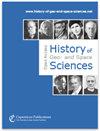新西兰第一个基于测量仪的海平面测量
IF 0.4
4区 哲学
Q4 GEOSCIENCES, MULTIDISCIPLINARY
引用次数: 0
摘要
摘要詹姆斯·库克的第二次南海航行是为了解决“大南方大陆”(Terra Australis Incognita)是否存在的问题,涉及两艘船只,“决心号”和“冒险号”。Longitude委员会任命了格林威治皇家天文台的两名天文学家,分别是William Wales和William Bayly,每艘船一名。除了天文任务外,他们还被要求观测潮汐的高度和时间。为此,Bayly和Wales于1773年在新西兰停留期间制造了潮汐计,并对海平面进行了定时测量。本文利用对潮汐的现代理解,回顾了这些潮汐观测,这是新西兰首次进行此类观测,假设在此期间,每个位置的潮汐区域没有发生重大变化。当与预测的(后预测的)天文潮汐相比时,大多数(80 %) 在20内商定的观测范围和时间 厘米和30 min。虽然他们的观测在今天几乎没有科学价值(除了表明18世纪末可以达到的质量之外),但贝利和威尔士不仅可以理所当然地宣称进行了新西兰的第一次潮汐测量,而且在可能的范围内,他们也有理由为自己的工作质量感到自豪。本文章由计算机程序翻译,如有差异,请以英文原文为准。
New Zealand's first gauge-based sea level measurements
Abstract. James Cook's second voyage to the South Seas, undertaken to settle the question regarding the existence or otherwise of the “Great Southern Continent” (Terra Australis Incognita), involved two vessels, the Resolution and Adventure. The Board of
Longitude appointed two astronomers from the Royal Observatory, Greenwich,
to the voyage, William Wales and William Bayly, respectively, one to each
vessel. They were instructed, in addition to their astronomical duties, to
observe the height and time of the tides. To this end, Bayly and Wales
fabricated tide gauges and conducted timed measurements of sea level during
their stopovers in New Zealand during 1773. This paper reviews those tidal
observations, the first of their kind in New Zealand, using modern understanding of the tide, assuming that no significant change in the tidal
regime at each location has taken place during the intervening period. When
compared to the predicted (hindcast) astronomical tide, the majority (80 %) of the observed ranges and times agreed within 20 cm and 30 min, respectively. Whilst their observations have little scientific value today (other than indicating the quality attainable in the late 18th
century), Bayly and Wales can not only rightfully lay claim to making New
Zealand's first tide gauge measurements but also, as far as it possible to
ascertain, be justifiably proud of the quality of their endeavours.
求助全文
通过发布文献求助,成功后即可免费获取论文全文。
去求助
来源期刊

History of Geo- and Space Sciences
GEOSCIENCES, MULTIDISCIPLINARY-HISTORY & PHILOSOPHY OF SCIENCE
CiteScore
1.50
自引率
33.30%
发文量
10
审稿时长
50 weeks
期刊介绍:
The scope of History of Geo- and Space Sciences (HGSS) is to document historical facts and knowledge and to improve awareness of the history of geoscience. The knowledge of the development of geosciences and their experimental methods and theories in the past can improve our current understanding and may stimulate current research. It is encouraging for young scientists to read biographical material of historical figures in their research area. It is important as well to learn that history of science is an integrated part of the ongoing research in their research area. Another important aim of the journal is the association of historical retrospective and current research.
 求助内容:
求助内容: 应助结果提醒方式:
应助结果提醒方式:


